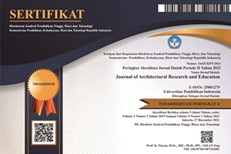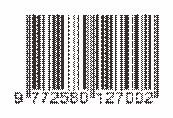APPLICATION OF THE DOUBLE SKIN FACADE CONCEPT IN AN EFFORT TO INCREASE THE THERMAL COMFORT OF IMAGE STUDIO ROOM
Abstract
Abstrak- The development of technology in buildings is one of the factors triggering the acceleration of methods in the facade configuration system. Double Skin Facade (DSF) is one of the building facade concept innovations. The purpose of applying the DSF concept is to optimize the use of energy related to the air conditioning system to obtain thermal comfort in buildings. The results of measurements of the existing condition of the Image Studio room in the morning until 11.00 are included in the optimal comfort category, 11.00 - 13.00 are in the warm comfortable category and starting at 13.00-18.00 tend not to meet thermal comfort. Based on the simulation results the use of Double Skin Facade can reduce the temperature in the room around 3.47oC. With the application of Double Skin Facade in this Image Studio room, it can reduce the heat radiation from sunlight that directly enters through the window because it can be detained first in the double facade. The application of Double Skin Facade can increase the thermal comfort of an Image Studio room.
Kata kunci- Double Skin Façade, Thermal Comfort
Full Text:
PDFReferences
Anonim. (1993). SNI T-14-1993-03: Standar Kenyamanan Termal. Jakarta: Puslitbang Departemen Pekerjaan Umum.
Anonim (2011). SNI 6197:2011, Konservasi energi pada sistem pencahayaan. Jakarta: Badan Standar Nasional.
Anonim (2011). SNI 6390:2011, Konsetvasi energi sistem tata udara bangunan gedung. Jakarta: Badan Standar Nasional.
Cheol-Soo Park (2003). Occupant Responsive Optimal Control of Smart Façade Systems A Thesis Presented to The Academic Faculty, College of Architecture Georgia Institute of Technology.
Hidayat, S. (2013). Fisika Bangunan. Jakarta: Pusat Pengembangan Bahan Ajar UMB.
Kragh, M. (2000). Building Envelopes and Environmental Systems. Paper presented at Modern Façades of Office Buildings Delft Technical University, the Netherlands Web address: http://www.permasteelisa.com/upload/docs/pub _TUD02001.pdf.
Lechner, Norbert (2007). Heating, Cooling, Lighting: Metode Desain untuk Arsitektur Edisi Kedua. Jakarta: PT RajaGrafindo Persada.
Lippsmeier, G., (1997). Bangunan Tropis (Terjemahan, Syahmir). Jakarta, Erlangga.
Loncour, X., Deneyer, A., Blasco, M., Flamant, G., Wouters, P. (2004). Ventilated Double Facades – Classification & illustration of façade concepts, Belgian Building Research Institute, 8 – 15, 17, 28 – 29.
Poirazis, H. & Rosenfeld, J.L.J. (2004). Double Skin Façades for office building Division of Energy and Building Design Department of Construction and Architecture Lund Institute of Technology Lund University, 2004 Report EBD-R--04/3. Diakses tanggal: 01 Mei 2012.
Saelens, D. & Hens, H. (2001). Experimental evaluation of naturally ventilated active envelopes, International Journal of Thermal Envelopes and Building Science, vol. 25, nr. 2, pp. 101-127. Diakses tanggal: 30 April 2012.
Satwiko, P. (2005). Fisika Bangunan 1, Yogyakarya: Andi.
Soegijanto. (1999). Bangunan di Indonesia dengan Iklim Tropis Lembab Ditinjau dari Aspek Fisika Bangunan. Jakarta: Ditjen Dikti Depdikbud.
Sugini. (2004). Pemaknaan Istilah – istilah Kualitas Kenyamanan Termal Ruang Dalam Kaitan dengan Variabel Iklim Ruang. Jurnal Logika, Vol.1, No.2, Juli 2004.
Sukawi. (2010). Kaitan Desain Selubung Bangunan terhadap Pemakaian Energi dalam Bangunan (Studi Kasus Perumahan Graha Padma Semarang). Jurnal Sains dan Teknologi, Volume 1, No.1.
Talarosha, Basaria. (2005). Menciptakan Kenyamanan Termal Dalam Bangunan. Jurnal SistemTeknik Industri, Volume 6, No. 3.
Zanghirella, F., Perino, M., Serra, V. (2010). A numerical model to evaluate the thermal behaviour of active transparent facades. Elsevier Journal Energy and Buildings 43 (2011), www.elsevier.com/locate/enbuild. 1125, 1123–1138.
DOI: https://doi.org/10.17509/jare.v2i1.24128
Refbacks
- There are currently no refbacks.
Copyright (c) 2020 Johar Maknun

This work is licensed under a Creative Commons Attribution-NonCommercial-ShareAlike 4.0 International License.

This work is licensed under a Creative Commons Attribution-ShareAlike 4.0 International License.








